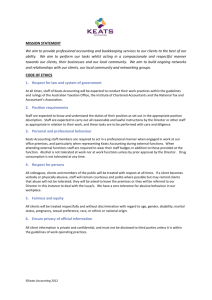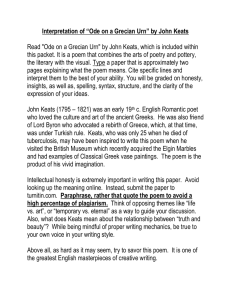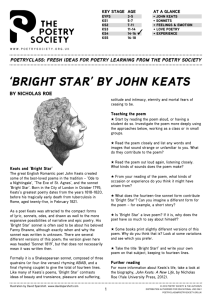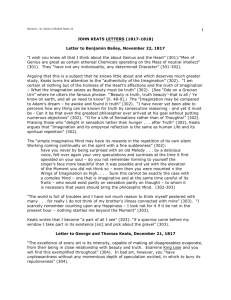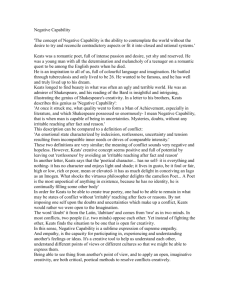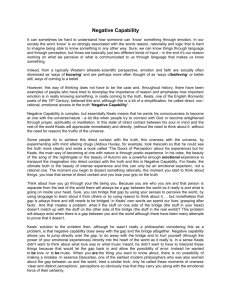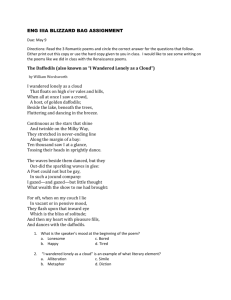John_Keats2
advertisement
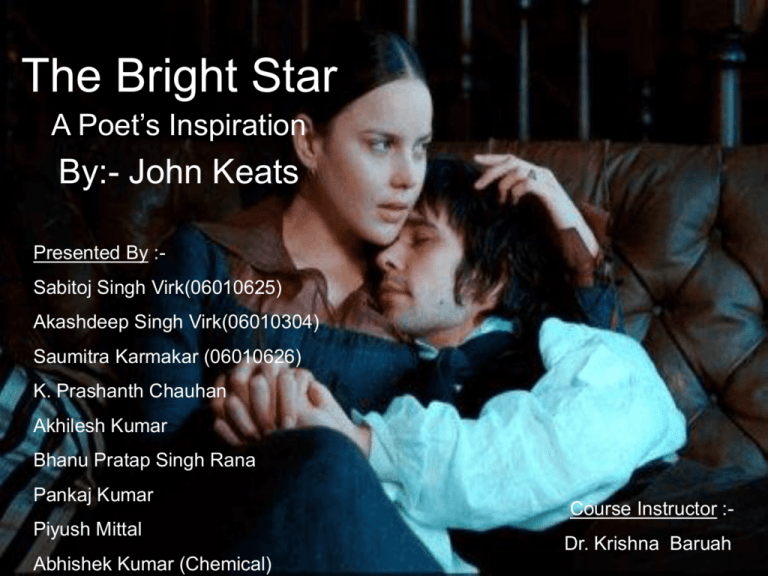
The Bright Star A Poet’s Inspiration By:- John Keats Presented By :Sabitoj Singh Virk(06010625) Akashdeep Singh Virk(06010304) Saumitra Karmakar (06010626) K. Prashanth Chauhan Akhilesh Kumar Bhanu Pratap Singh Rana Pankaj Kumar Piyush Mittal Abhishek Kumar (Chemical) Course Instructor :Dr. Krishna Baruah Romanticism • Romanticism is a complex artistic, literary, and intellectual movement that originated in the second half of the 18th century in Western Europe, and gained strength in reaction to the Industrial Revolution. • Definitions of Romanticism : "liberalism in literature” – freeing of artist from restrains and encouragement of revolutionary ideas. revival of medievalism in art, letters, and life the predominance of imagination over reason and formal rules (classicism) and over the sense of fact or the actual (realism). “a psychological desire to escape from unpleasant realities” Pre-Romanticism –AGE OF REASON – art, nature etc were subject to mechanical laws created by GOD . This was the legacy of the move into the scientific age (enlightenment) from the religious age (the dark ages) • Romanticism was inspired by revolutionary idealism (1789 French Revolution) and rejected this rigid social and intellectual hierarchy and replaced it with wildness and emotion. Dreams and Imagination were valued. Romanticism in English Literature • Certainly, the Romantic period was shaped by a multitude of political, social, and economic changes. Many writers of the period were aware of a pervasive intellectual and imaginative climate, which some called “the spirit of the age”. This spirit was linked to both the politics of the French Revolution and religious apocalyptic. • Wordsworth and Coleridge’s sense of the emancipatory opportunities brought in by the new historical moment was expressed, for example, in their Lyrical Ballads, which revolutionized the theory and practice of poetry. Wordsworth influentially located the source of a poem no in outer nature but in the psychology and emotions of the individual poet. In keeping with the view that poetry emphasizes the poet’s feelings, the lyric became a major Romantic form. It was held that the immediate act of composition must be spontaneous -arising from impulse and free from rules. For Shelley, poetry was not the product of “labour and study” but unconscious creativity • Imagination was elevated to a position as the supreme faculty of the mind, contrasting with the traditional arguments for the supremacy of reason. • Imagination was elevated to a position as the supreme faculty of the mind, contrasting with the traditional arguments for the supremacy of reason. Imagination was, then, the primary faculty for creating all art. On a broader scale, it was also the faculty that helped humans to constitute reality, for as Wordsworth suggested, we not only perceive the world around us, but also in part create it • 1795-1821 • English poet, b. London. • He is considered one of the greatest of English poets. Life • John Keats, one of the greatest English poets and a major figure in the Romantic movement, was born in 1795 in Moorefield, London. His father died when he was eight and his mother when he was 14; these sad circumstances drew him particularly close to his two brothers, George and Tom, and his sister Fanny. • Keats was well educated at Clarke school in Enfield, where he began a translation of Virgil's Aeneid. In 1810 he was apprenticed to an apothecary-surgeon. His first attempts at writing poetry date from about 1814, and include an `Imitation' of the Elizabethan poet Edmund Spencer. • In 1815 he left his apprenticeship and became a student at Guy's Hospital, London; one year later, he abandoned the profession of medicine for poetry. Early stages in the Romanticism period in poetry Poets believed in: • nature • beauty • freedom • emotion Used visual images to portray this. John Keats was influenced by: •Percy Bysshe Shelly •Samuel Taylor Coleridge •William Wordsworth •Other writers of the time, and all key protagonists in the romanticism movement. • Keats' first volume of poems was published in 1817. It attracted some good reviews, but these were followed by the first of several harsh attacks by the influential Blackwood's Magazine. Undeterred, he pressed on with his poem `Endymion', which was published in the spring of the following year . • Keats toured the north of England and Scotland in the summer of 1818, returning home to nurse his brother Tom, who was ill with tuberculosis. After Tom's death in December he moved into a friend's house in Hampstead, now known as Keats House. • There he met and fell deeply in love with a young neighbour, Frances Brawne. Brawne (1800-1865) later became his fiancee. Keats's letters to Frances Brawne are among the most famous love letters ever written. As next door neighbors, they exchanged numerous short notes, and occasionally more passionate ones Frances Brawne (1800-1865) • During the following year, despite ill health and financial problems, he wrote an astonishing amount of poetry, including `The Eve of St Agnes', 'La Belle Dame sans Merci', `Ode to a Nightingale' and `To Autumn'. • His second volume of poems appeared in July 1820; soon afterwards, by now very ill with tuberculosis, he set off with a friend to Italy, where he died the following February. When Keats became ill he was unable to have any physical contact with Frances, so they would send letters to each other and would see each other through glass screens. • Keats and his friend Joseph Severn arrived in Rome, after an arduous journey, in November 1820. They found lodgings in a house near the Spanish Steps. Keats rallied a little at first, and was able to take gentle walks and rides, but by early December he was confined to bed, extremely ill with a high fever. • Severn nursed him devotedly throughout the next few distressing and painful weeks. Keats died peacefully, clasping his friend's hand, on 23 February 1821. • Keats requested that on his tombstone all that would be written was "Here Lies one whose name was writ in water". However Keats’ friend ,Charles Brown felt that this was too short and had this carved into the tombstone: "This Grave contains all that was Mortal of a YOUNG ENGLISH POET Who on his Death Bed, in the Bitterness of his heart ,at the Malicious Power of his Enemies, Desired these words to be engraved on his Tomb Stone “Here lies One Whose Name was writ in Water" Tombstone on John Keats ‘ Grave Ode on Grecian Urn Bright Star The Bright Star • Bright star, would I were stedfast as thou art-Not in lone splendour hung aloft the night And watching, with eternal lids apart, Like nature's patient, sleepless Eremite, Explanation :In this scenario, the metaphor here is between the star and himself (Keats). The poet establishes the image of the star that is the central focus of the poem. The star is said to be eternal ("patient"), unchanging ("sleepless"), and beyond the speaker's immediate grasp ("aloft"). the star is immortal "And watching, with eternal lids apart,"; unlike him, who is sick and knows he is going to die soon. He wishes he didn’t have to die so that he could be with his loved one. The moving waters at their priestlike task Of pure ablution round earth's human shores, Or gazing on the new soft-fallen mask Of snow upon the mountains and the moors— Explanation :The second part of the octave describes what the star watches. Here, two symbols emerge, both suggesting the idea of pureness. The first is the “moving waters” the star watches over.The waters here take on a spiritual significance, their “ablution” suggesting religious purification, “a priestlike task” that is performed on the “human shores.” The second symbol is contained in the image of snow: “the new soft-fallen mask” that covers “the mountains and the moors.” By introducing these images, the speaker seems to identify with those things that can, in some sense, make humans pure or spiritual. Perhaps he feels this to be a way to transcend the limitations of human life — the changes and eventual decay that result in death. No--yet still stedfast, still unchangeable, Pillow'd upon my fair love's ripening breast, To feel for ever its soft fall and swell, Awake for ever in a sweet unrest, Still, still to hear her tender-taken breath And so live ever--or else swoon to death. Explanation :- Change of observation from Star to Himself • In line 11, the reference is made to the “soft fall and swell” of the woman’s breast, which also suggests water and waves. In comparison to the rise and fall of ocean waves as expressed by Line 5. • The speaker however wishes for something that the star doesnot have –steadfastness without solitude .Though he wishes to be immortal like the star but only in context of his Love for his soulmate . While the star is merely “watching”the “moving waters,” the speaker wishes to actually “feel” his love’s living body. • While the star fails to sense the procession of time — it is “patient” —the speaker envisions an eternity of “sweet unrest.” • Keats seems to feel that watching life changing from afar would be better than living in it and having to change with it. • He ends the poem by saying that he would like to live as a star “or else swoon to death”. It is apparent that Keats understands the sacrifices of living as a star, but acknowledges its benefits as well. • In the poem “Bright Star” by John Keats the desire to experience a life that never moves forward is expressed. The impossibility of this desire leads to its melancholic feeling. • It was believed that John Keats Inspiration to write the poem “Bright Star “ was his immense love for his muse Frances Brawne and his intense desire to live his love for eternity which he could see was not possible due to his impending death at the hand of tuberclosis. • Another such allusion to his Love life with Frances Brawne can be noticed in the poem “Ode on Grecian Urn “ as given below : In the second stanza, Keats looks at a picture on the urn, a young man playing a pipe, lying with his lover beneath a glade of trees. He says that the piper's "unheard" melodies are sweeter than mortal melodies because they are unaffected by time. He tells the youth that, though he can never kiss his lover because he is frozen in time, he should not grieve, because her beauty will never fade. He is happy for the piper because his songs will be "for ever new," and happy that the love of the boy and the girl will last forever, unlike mortal love( Here a reference made to his love for Fanny ), which lapses into "breathing human passion" and eventually vanishes, leaving behind only a "burning forehead, and a parching tongue." Ode to a Nightingale Inspired by his brother’s death • Referred to by critics of the time as "the longest and most personal of the odes," the poem describes Keats” journey into the state of Negative Capability. The poem explores the themes of nature, transience and mortality, the latter being the most personal to Keats, making as he does a direct reference to the death in 1818 of his brother, Tom. • The image of human misery is very profound when Keats alludes to his brother’s death: "Where youth grows pale , and spectre-thin and dies; Where but to think is to be full of sorrow and leaden-eyed despairs". • This image, of the youth dying and transient nature of love, is further heightened by the image of Keats” predicting his own death. As the poem progresses, Keats associates his death with the song. The image used by Keats of a human body becoming a clod of earth, the human body becoming one with the earth creates a vision of coffin being lowered into grave and covered by shovels of earth, the human body becoming one with earth A Letter to Frances Brawne Feb,1820 . Letters and Quotes to Frances Brawne • ". . .I love you; all I can bring you is a swooning admiration of your Beauty. . . . You absorb me in spite of myself--you alone…... I will imagine you Venus tonight and pray, pray, pray to your star like a Hethen.“ May 3, 1818 Keats closed the letter, "Your's ever, fair Star." This letter is many times connected to the sonnet "Bright Star" because of the references to Fanny as a star and because of the connection of death, love, and swooning (compare this connection to the last line of the sonnet). • In my present state of Health I feel too much separated from you and could almost speak to you in the words of Lorenzo's Ghost to Isabella Your Beauty grows upon me and I feel A greater love through all my essence steal. • "I almost wish we were butterflies, and lived but three summer days. Three such days with you I could fill with more delight than fifty common years could ever contain." “You are the brightest, most delicate thing."
